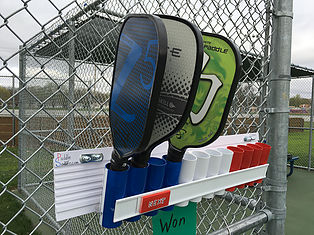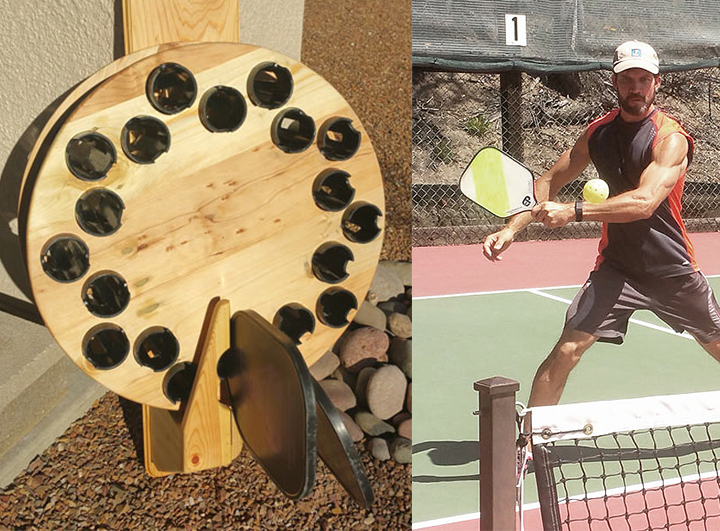Play Pickleball
The melodic rhythm of bouncing balls, friendly banter, and the exhilarating thrill of a well-played game are the hallmarks of pickleball, a sport that has been captivating hearts nationwide. However, as more enthusiasts join the fold, attending open play sessions and partaking in the competitive camaraderie, there arises a slight hiccup — the chaos of scattered paddles, disrupting the flow of games and causing minor confusions. However, with every challenge comes an opportunity, and Pickleball Central is up for the task. Organizing paddles isn't just a prelude to playing the game, but an art, an enhancement to the overall gaming experience. Whether you're a seasoned player or a beginner just finding your groove, understanding the importance of paddle organization is key. In this guide, we'll delve deep, exploring innovative ways to keep your paddles in check, ensuring that the only thing you need to focus on during open play is the game itself. Ready to elevate your pickleball experience? Let's dive right in!

Understanding Open Play
To truly appreciate the nuances of organizing, one must first grasp the essence of open play in the realm of pickleball. Open play is not just about freestyle matches; it's the soul of the community. It's where everyone, from seasoned pros to enthusiastic beginners, can come together, matching skills, sharing tips, and fostering a sense of unity. Picture this: the sun shining down on a court buzzing with energy, players waiting eagerly for their turn, and amidst all this, the slight hitches — where's my paddle? Whose turn is next? The beauty of open play is in its spontaneity and freedom, but without a touch of organization, this freedom can lead to minor chaos. The challenge here is to maintain the fluidity of open play while infusing a structure that ensures smooth transitions, minimal waiting times, and an uninterrupted flow of matches. By understanding the dynamics of open play, we can better appreciate the methods and tools that will help maintain its essence while eliminating potential disruptions.
 (Image Credit: Jennifer Lucore)
(Image Credit: Jennifer Lucore)
1. Pickleball Paddle Rack
Enter the pickleball paddle rack —a pickleballer's best friend when it comes to organization. These racks are specially designed to hold multiple paddles, ensuring they're always within arm's reach but never in the way.
- Easy Access: No more scrambling around. Pick a paddle and jump straight into the game.
- Safety: Paddles on the ground are trip hazards. Racks eliminate this risk, ensuring a safer play environment.
- Pro Tip: If you're a regular at a community court, consider rallying fellow players to invest in a communal rack. It's a small addition that can massively enhance the playing experience.
2. DIY Pickleball Paddle Holder
For those who love a touch of personal flair, why not craft your own pickleball paddle holder? With a bit of creativity, you can create functional yet aesthetically pleasing holders.
- Materials: Old wooden crates, some paint, hooks.
- Steps:
- Paint the crate in vibrant colors or themes.
- Fix hooks inside the crate's upper edge.
- Mount the crate on a nearby wall or place it conveniently near the court.
- Advantages: Not only does this method offer storage, but it also becomes a conversation starter, reflecting your personal style.
3. Designated Play Zones
Remember the old school days of having designated areas for bags? Take that concept and bring it to the pickleball court. Assign specific zones or corners for paddle placement.
- How It Works: Use colored cones or use chalk or markers to highlight paddle zones.
- Benefits: It streamlines gameplay, especially during breaks. Players can easily pick up or place their paddle without disturbing ongoing matches.
4. Color-Coded Pickleball Rack Systems
When dealing with large groups or clubs, a color-coded pickleball rack system is a lifesaver. By assigning colors to different skill levels or teams, players can quickly find and store their paddles.
- Implementation: Use colored tapes or tags on the rack. Each color corresponds to a specific group or skill level.
- Advantage: This system is especially useful during tournaments, ensuring smooth transitions between matches without confusion.
5. Rotation-Based Paddle Placement
For those truly competitive open play sessions, consider a rotation-based system. The idea is simple: as players finish their games, they place their paddles at the back, and the next in line take the paddles from the front.
- Execution: Create a designated area with a clear 'front' and 'back'. Use signs to guide players.
- Merit: This ensures everyone gets their turn, and no one monopolizes the court. Plus, it adds an exciting strategic element to the game!
The world of pickleball is vast and vibrant, a unique blend of sport, strategy, and camaraderie. And while the game itself is the star of the show, the little nuances, such as organized paddle placements, play a vital role in enhancing the overall experience. As the pickleball community grows, so does the responsibility of ensuring that every player, whether a novice or a seasoned pro, enjoys a hassle-free game. The art of organizing paddles, as explored in this guide, offers just a glimpse into the commitment of the pickleball community to foster a seamless playing environment. It's a reflection of the sport's core values — unity, respect, and passion. In essence, pickleball is more than just swift moves and powerful serves; it's about creating memories, forging bonds, and sharing moments of joy. And with an organized system in place, players can focus on what truly matters — the love of the game. So, as you step onto the court the next time, take a moment to appreciate the organization, dive into the game, and cherish the symphony of pickleball in all its glory. Cheers to many more games and many more memories!
Share Product:
SHARE THIS:


